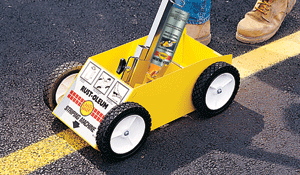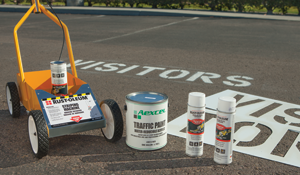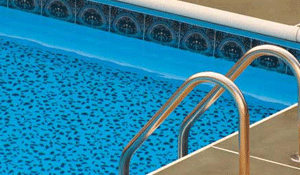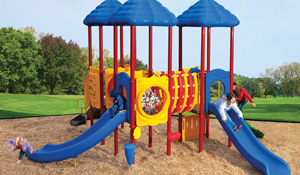Outdoor Painting Projects Guide
Over time, exposure to weather, sunlight, and normal wear and tear will eventually damage any outdoor painted surface. Once you see signs of paint fading, cracking, flaking, or peeling, it's time to repaint.
Maintain a great looking property by keeping parking lots, pools/spa areas, and playground equipment freshly painted and looking like new. Use these tips to easily refresh your property.
Parking Lots

Your parking lot is one of the first things residents and guests see. Make sure it's safe, easy to navigate, and regularly painted. Our selection of do-it-yourself painting and patching supplies makes it easy to get professional-looking results without the professional expense. And, most jobs can be completed in hours, not days.
Parking Lot Paint Jobs
Painting helps you control and direct traffic around your parking lot. Here are four easy ways to make your parking lot safe and user-friendly:
- Use high-performance traffic and striping paint and a paint striper to paint lines for parking spaces and pedestrian crosswalks on asphalt or concrete.
- Paint curbs, curb stops, and bollard posts bright yellow or red to maximize visibility.
- Use stock or custom plastic stencils to mark enter/exit areas, handicap and visitor spaces, fire lanes, traffic directions, and more.
- Post parking signs as needed.
Remember, painting a parking lot can be a big job. Make it more manageable by dividing the parking lot into sections and tackle only one area at a time.
Patch and Repair Pavements

Weather conditions and everyday traffic can take a toll on even the best maintained roads and parking lots. If you notice cracks or holes in the pavement, fix them as soon as possible. Follow these best practices for a successful asphalt repair:
- Size It Up—For cracks less than a 1⁄2 inch wide, use a caulking gun to apply crack filler. Wider gaps may require an asphalt pothole patch that permanently bonds to asphalt pavement. For best results, fill deep cracks with sand and larger potholes with gravel before making the repair.
- Sweep Away Debris—Use a broom or hose to remove loose gravel or bits of broken asphalt. Pull out or kill any weeds as well. In some cases, you may need to make the crack or hole larger to completely remove any weakened sections.
- Check the Weather—Warm, dry days are best for asphalt repair and sealing, especially if you are using a cold patch product. Repairing cracks and potholes is not recommended during colder months.
- Tamp It Down—After filling the crack or hole, use a tamping tool to create a better bond and eliminate air holes. You'll want to tamp twice. Once when the crack or hole is almost filled with the patch, and a second time after the patch is filled slightly over the rim.
- Seal When Done—Apply two coats of a high quality sealer to reinforce the bond between existing asphalt and the new repair. Sealing the repair keeps moisture out and helps the patch last longer.
Preventative Maintenance
The following tips will help keep your parking lot in good condition and save you money on repair costs.
- Keep It Clean—Trash and leaves can stain pavement. Use a blower or broom to remove any debris. Fuel and oil stains can be removed with an industrial degreaser. If the stain is fresh, use an all purpose absorbent to soak up the excess, then dispose of it correctly.
- Repair Potholes Quickly—Don't let a small crack or pothole turn into a bigger problem. Left unchecked and unrepaired, cracks and holes only get worse, weakening the integrity of the asphalt and increasing the cost of repairs.
- Apply Sealer—Sealing prolongs the life of the asphalt by blocking water, UV rays, and vehicle fluids. Experts recommend applying asphalt sealer every three to five years to maximize protection.
Pool and Spa Areas

Your swimming pool and spa are valuable amenities that attract residents and guests. Painting is one of the best ways to protect your investment by keeping your pool and spa looking like new.
Tile Patch and Repair
Loose or broken tiles around your pool or spa are an accident waiting to happen. Use an underwater tile repair kit to fix damaged tiles in pools, spas, or fountains without draining the water.
Pool Paint Prep Tips
Before painting the inside of a swimming pool, spa, or fountain, clean and degrease the surface for better paint coating and adhesion. Rust-Oleum Pool Cleaner & Prep Solution cleans all painted surfaces, removes mineral deposits, and makes concrete surfaces more porous for better paint coating.
Acrylic vs. Epoxy Pool Paint
Choosing the right pool paint is key to a successful pool painting job. Acrylic pool paints and epoxy pool paints are the most common types of coating used for pools, spas, and fountains. Each type of paint has advantages. Learn more about pool paint.
If your pool is already painted, you need to know the existing pool paint type. Not all paints are compatible with one another. Using the wrong paint type can create poor adhesion and blistering. For example, if your pool currently has an epoxy paint surface, you must repaint with epoxy paint instead of an acrylic paint.
Also, make sure to get the right paint roller for a quality finish and ease of application. Rollers hold a large amount of paint for improved efficiency and productivity. Learn more about paint applicators.
Playground Equipment

Playground equipment with chipped or flaking paint is more than an eyesore. It's also a serious health and choking hazard for children. Inspect your play equipment regularly for signs of aging or damaged paint, then promptly repair or repaint. Use the following tips to give play equipment a fresh look and a durable, long-lasting finish:
If you're painting metal equipment:
- Scrape off loose and flaking paint pieces with a wire brush
- Clean away dirt, rust, grease, etc. with a wet, soapy rag
- Sand surfaces with a fine-grit sandpaper and wipe clean
- Apply etch primer to form a good paint bond
- Use the two coats of exterior-grade, lead-free paint
If you're painting wooden equipment:
- Use wood putty to fix holes and gouges
- Sand down rough areas to prevent splinters
- Use two coats of exterior-grade, lead-free paint, or if not painting, apply a water sealer or wood preservative
Painting playground equipment with a regular brush can be time and labor intensive. The innovative Wooster Jumbo-Koter Pipe Painter with adjustable twin rollers lets you quickly paint two sides of a pipe or pole simultaneously. Watch this video to see how fast and easy painting play equipment can be.
